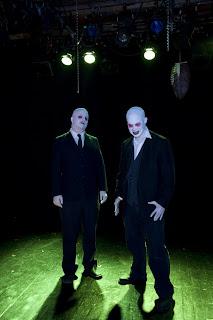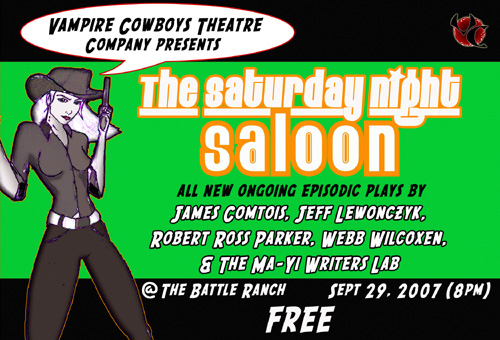(The following essay - as with all horror film essays on Jamespeak - contain spoilers. If you have not seen the film and don't want anything ruined for you, I suggest you read no further.)
***
"My family's always been in meat."
-The Texas Chain Saw Massacre
In The Texas Chain Saw Massacre, five young people drive through Texas to spend the weekend in an old house two of the young people grew up in. They pass by a slaughterhouse, which starts a reluctant discussion in the van about the upgrades in cattle-slaughtering technology: in the olden days, the workers killed the cows by hitting them in the heads with a hammer. Now, there's a new air gun that theoretically kills the cows instantaneously (and therefore more humanely).
As Franklin (Paul A. Partain), the wheelchair-bound slaughterhouse enthusiast continues to expound on the positive aspects of the air gun, the fivesome notices a very odd-looking hitchhiker (Edwin Neal) and decides to pick him up.
They ask the hitchhiker, who seems physically and mentally damaged, where he's been and where he's going. He's going home after taking pictures at the old slaughterhouse. Franklin asks the hitchhiker to weigh in on the value of the gun, which upsets the hitchhiker. "The air gun's no good," he says. The gun caused people to lose their jobs, specifically implying members of his family. He prefers hitting the livestock in the head with a hammer.
Later in the film, one of the five vacationers (Kirk, played by William Vail) enters a nearby farmhouse to ask if they can get some gas for the van.
Upon entry, one of the farmhouse's inhabitants, a giant man (Leatherface, played by Gunnar Hansen), making terrified pig-like squealing noises and wearing a mask made of what appears to be human flesh, panics and hits Kirk in the head with a hammer, killing Kirk instantly.
Later, Kirk's girlfriend Pam (Teri McMinn), tired of waiting for her boyfriend, enters the house, and finds a room littered with bones and skins from various animals - humans, cows, chickens - teeth, and chicken feathers. She starts to feel sick and runs out of the house. Leatherface, however, sees her, panics again, chases her, pulls her into the house, and plants her on a meat hook (a freakin' meat hook, people!) before resuming carving her boyfriend up (for, we later discover, dinner) with the titular chain saw.
We discover that the Sawyer family inhabits the farmhouse, which is made up of retarded grave robbing cannibals, and that the hitchhiker the kids picked up is Leatherface's brother.
If there's an underlying message to Tobe Hooper's 1974 film, The Texas Chain Saw Massacre, a movie that simultaneously revels in and transcends its grindhouse/Grand Guignol roots, it's that we're all cattle.
It is also quite possibly the most terrifying and effective horror film ever made.
Despite living up to its name and reputation as being horrifically over-the-top and relentless (in his original review, Roger Ebert wrote: "[it] is as violent and gruesome and blood-soaked as the title promises."), The Texas Chain Saw Massacre is also quite subtle, something none of its imitators seem to grasp. The movie, for example, lets the audience figure out for themselves in hindsight what the vacationers are eating when they make the pit stop at the gas station/barbecue shack.
(Tangential trivia tidbit: for those who pay close attention and are really interested, Leatherface's real name in the movie is Bubba Sawyer [his brother calls him that when he asks for help bringing Grandpa (John Dugan) down the stairs]. I've never been able to catch what the other family members' names are, or if they're even mentioned. We only know their surname because we see a shot of the mailbox late in the film.)
Although using a number of stock horror movie conventions (kids playing in an abandoned house, kids entering a stranger's house, the van that's out of gas), none of them feel like clichéd conventions and many of them turn out to be red herrings.
In other words, there's no point in the movie where you think, "These people are stupid." When I watch it I realize I wouldn't behave or respond too differently. That the dialogue is often improvised also gives the characters - and movie - a sense of realism that helps making The Texas Chain Saw Massacre so horrific.
The first half of the film is shot almost documentary style, with very few flashy or fancy cuts or camera angles. The use of music is minimal (and mostly live). The day that the teenagers land their van by Sally (Marilyn Burns) and Franklin's father's house is about as idyllic and unthreatening as you can get. When Kirk goes into what turns out to be Leatherface's house, there's nothing ominous about it: it's a fairly regular-looking farmhouse (some would say that the bizarre makeshift decorations in the front yard are clear warning signs, but they're really part-in-parcel with most farmhouses. If you're in the North Atlantic, check out some farmhouses in upstate New York or New England and you'll see what I mean).
The second half is ultimately Sally, the one and only survivor from the group, running for her life, screaming her lungs out and being terrified out of her mind. It's here where Hooper and cinematographer Daniel Pearl abandons the documentary style for quick cuts, extreme close-ups (seriously, how far into Burns's eye does that camera go?) and intense music cues.
It is, in a word, relentless. And I do mean Re. Lent. Less.
Hooper does a masterful job keeping the audience with Sally the whole time: we not only empathize and identify with her, we feel like we're running for our lives ourselves. Every time I watch the final act of the film I feel like my appendix is about to burst, thinking that I couldn't possibly run that fast for that long without collapsing.
Although Hooper has said in interviews that this film was a response to Watergate and Vietnam (then again, weren't all horror movies in the '70s purported to be responses to Watergate and Vietnam?), and one can make an argument for such an angle (the movie is, after all, about hippies getting slaughtered), it's more obviously a response to the meat processing industry, our assembly-line culture (the Sawyer family consists of laid off slaughterhouse workers) and an argument against eating meat.
I admit I find it vaguely amusing that such a vicious and graphic film is ultimately a plea for vegetarianism, but then again many of the horror films of the '70s were far from subtle with their messages.
The Texas Chain Saw Massacre is one of those movies that is both part of and creator of a formula that no film or filmmaker has quite been able to duplicate, not even Hooper himself. The humor found in Chain Saw, and yes, there is some humor (how else do you describe the Sawyer family acting as cheerleaders to their senile and semi-conscious Grandpa who tries - and fails - to hit Sally in the head with the hammer, or when we see Leatherface in a matronly mask, wig and apron preparing for dinner?), is too blunt and broad in the Hooper-directed Texas Chainsaw Massacre 2.
The film is so effective, powerful and well made it almost defies analysis. Sure, there is a lot of "meat" to the film (pardon the pun), but no one goes to see this film to hear a commentary on the meat processing industry or an argument for vegetarianism. However, the morality behind the film helps it transcend being merely an exercise in artless cruelty and nihilism.
Not eating headcheese,
James "Bubba Sawyer" Comtois
Labels: film, horror











